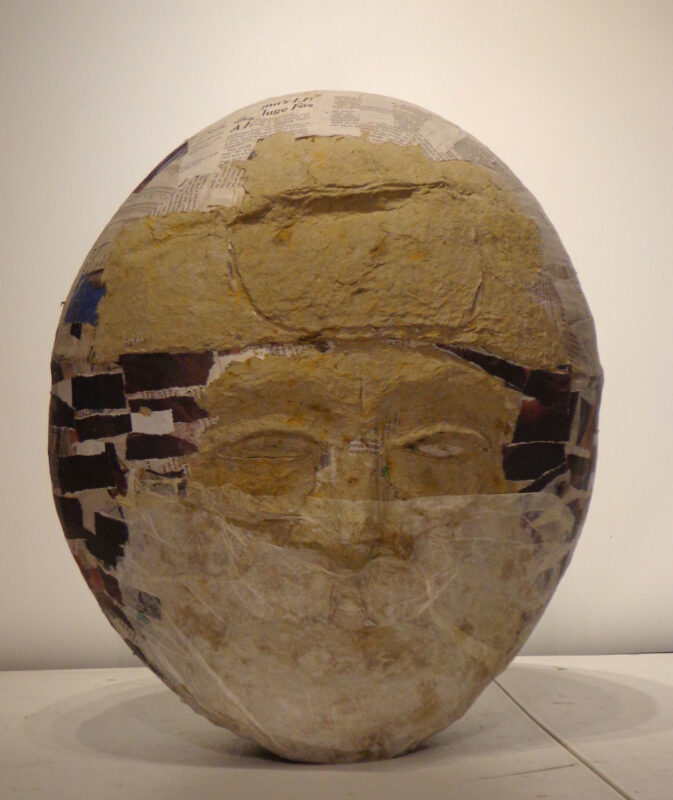
How did showing in the exhibition impact your career as an artist?
“I enjoyed hearing the curator, Julien Robson, describe how he conceived the show; my appearance led to inclusion in an art co-operative.”
Artist Statement
My art comes from paper-mâché in very specific ways. I can mumble and futz around with the ideas that informed the conception of an individual relief-collage or marionette, but the work originates in my life-long exploration of paper strips and paste: what they can do, the myriad forms cataloged in the muscles and recognized in the eye. When we speak about the hand of the artist, the unique signature of his or her interaction with a medium, description is plainly the vain attempt to communicate with words a purely existential phenomenon. The hand of the artist–that ineffable trace of an individual life interacting with the material–to me is the salient production of every work of art.
Artist Biography
Drew Zimmerman lived on a homestead in West Virginia in 1980, and has since spent his art career in row houses and apartments within Philadelphia and the comfortable suburbs of Lower Merion Township. He is a self-taught artist whose primary materials are paper-mâché, found newsprint and cardboard, 16-gauge wire, and digital videography.
His initial passion was marionette building and performance, having become hooked on the animation of inanimate objects by the television work of Jim Henson and Mabel Beaton, or perhaps earlier (who knows?), in his crib, watching adults make flying objects out of blocks and rattles. In the early 80s, his interest led to regular street performances in Headhouse Square. Zimmerman collaborated with his brother, Lee, who later had a successful Hollywood stage and television career, using a fiery Jimi Hendrix marionette that Drew helped to build, and dozens of other characters dependent on his older brother’s basic paper-mâché-over-a-wire-frame design.
Paper-mâché was perfect for making any sort of performance prop, and in addition to building puppets, Zimmerman created dozens of portrait and “monster” masks. In his early twenties, he worked in a china doll factory, where his job was to pour the porcelain slip in and out of plaster molds. A co-worker advised him how to represent the most challenging likenesses of his freelance mask-making, using a four-step process: sculpt a figure in clay, create a mold of it in plaster of Paris, fill the mold with strips of newsprint and paste, and pop the form out of its negative after it was dry. Many of the molds he made had several sections, and he tackled the problem of piecing together different parts of the same sculpture.
By 1990, when he was hired to make props for “The Bozo Show” on local Philadelphia station WGBS-TV, Zimmerman had begun using the technique of coloring a sculpture’s surface with paper strips of “found” newspaper advertisements. The results retained the texture and marvel of beautiful objects made from ordinary trash. The wonderful feel of a paper-mâché surface was more desirable than the plastic touch of acrylic paint; torn strips of complimentary colors laid side-by-side were lovelier and more expressive than brushwork. He thrived on the slow, slow accumulation of narrow, wafer-thin bits that was most suited to his self-taught technique.
In the mid-Aughts, following a career as a high school English teacher, Zimmerman’s first projects were marionette musical satires, for which he wrote the scripts and the score, built the characters and sets, and operated the digital camera. (Pitcher: Bugs Bunny; catcher: Bugs Bunny; center field: Bugs Bunny, and so forth.) In a parallel development, he began to use paper-mâché as a portrait-making material. An innovation in his work was the use of a cardboard undercarriage that added relief to a flat surface, taking advantage of the sculptural properties paper and paste have over paint on canvas. The method, which he called “relief-collage,” led to the inclusion of his work in several exhibitions for the Art in City Hall program, directed by Tu Huynh. “Toying With Art” was the first of these, its call for artists practically jumping off the page, considering Zimmerman’s use of paper. Other early shows that included his unique pieces were the Betsy Meyer Memorial exhibits of ‘08 and ‘09 at Main Line Art Center. Both venues had a mission of community engagement, and Zimmerman was, after all, an indigenous artist.
Showing juried work sparked an invitation in 2010 to join the Muse Gallery artists’ co-op on Second Street in Old City. He exhibited in their group shows, organized a juried presentation of local artists, and had two shows of his own, “Do I Amuse You?” in 2011 and “What I Don’t Know Can’t Hurt You” in 2012. Zimmerman’s first two-year tenure with the Muse Gallery included 12 months when he was its director. (He belonged to the organization for another two-year service in 2020-2022, the highlight of which was his solo show “Guerrilla Theater” in 2021.) Prominent juried exhibitions in which Drew Zimmerman participated over the last decade included two invitations to join Art of the State in Harrisburg: in 2011, a relief-collage was chosen as the Second Prize winner in the craft category, and the 2015 show included two of the artist’s pieces.
In 2019, he showed in the “Crafting Narratives” exhibition for Art in City Hall, and he was selected to participate with three separate works of free-standing sculpture for “Art in the Time of Covid,” presented by the Atlantic Highlands Art Council in winter of 2020. In 2021, the 14-minute video of his satire “Lisa Strata” was featured in a show of digital art at Touchstone gallery in Washington, D.C.